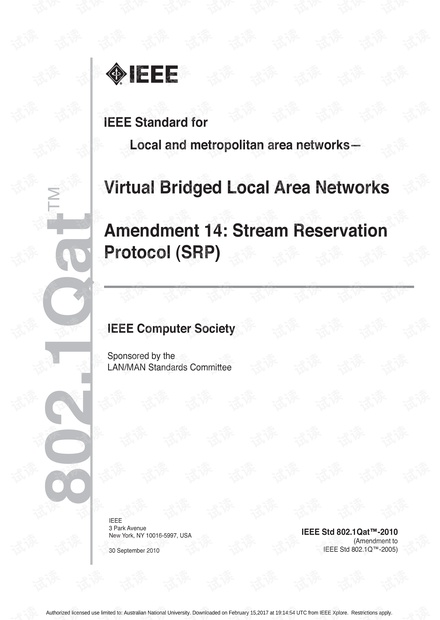
IEEE Standards documents are developed within the IEEE Societies and the Standards Coordinating Committees of the IEEE
Standards Association (IEEE-SA) Standards Board. The IEEE develops its standards through a consensus development process,
approved by the American National Standards Institute, which brings together volunteers representing varied viewpoints and interests
to achieve the final product. Volunteers are not necessarily members of the Institute and serve without compensation. While the IEEE
administers the process and establishes rules to promote fairness in the consensus development process, the IEEE does not
independently evaluate, test, or verify the accuracy of any of the information or the soundness of any judgments contained in its
standards.
Use of an IEEE Standard is wholly voluntary. The IEEE disclaims liability for any personal injury, property or other damage, of any
nature whatsoever, whether special, indirect, consequential, or compensatory, directly or indirectly resulting from the publication, use
of, or reliance upon this, or any other IEEE Standard document.
The IEEE does not warrant or represent the accuracy or content of the material contained herein, and expressly disclaims any express or
implied warranty, including any implied warranty of merchantability or fitness for a specific purpose, or that the use of the material
contained herein is free from patent infringement. IEEE Standards documents are supplied “AS IS.”
The existence of an IEEE Standard does not imply that there are no other ways to produce, test, measure, purchase, market, or provide
other goods and services related to the scope of the IEEE Standard. Furthermore, the viewpoint expressed at the time a standard is
approved and issued is subject to change brought about through developments in the state of the art and comments received from users
of the standard. Every IEEE Standard is subjected to review at least every five years for revision or reaffirmation, or every ten years for
stabilization. When a document is more than five years old and has not been reaffirmed, or more than ten years old and has not been
stabilized, it is reasonable to conclude that its contents, although still of some value, do not wholly reflect the present state of the art.
Users are cautioned to check to determine that they have the latest edition of any IEEE Standard.
In publishing and making this document available, the IEEE is not suggesting or rendering professional or other services for, or on
behalf of, any person or entity. Nor is the IEEE undertaking to perform any duty owed by any other person or entity to another. Any
person utilizing this, and any other IEEE Standards document, should rely upon his or her independent judgment in the exercise of
reasonable care in any given circumstances or, as appropriate, seek the advice of a competent professional in determining the
appropriateness of a given IEEE standard.
Interpretations: Occasionally questions may arise regarding the meaning of portions of standards as they relate to specific applications.
When the need for interpretations is brought to the attention of IEEE, the Institute will initiate action to prepare appropriate responses.
Since IEEE Standards represent a consensus of concerned interests, it is important to ensure that any interpretation has also received the
concurrence of a balance of interests. For this reason, IEEE and the members of its societies and Standards Coordinating Committees
are not able to provide an instant response to interpretation requests except in those cases where the matter has previously received
formal consideration. A statement, written or oral, that is not processed in accordance with the IEEE-SA Standards Board Operations
Manual shall not be considered the official position of IEEE or any of its committees and shall not be considered to be, nor be relied
upon as, a formal interpretation of the IEEE. At lectures, symposia, seminars, or educational courses, an individual presenting
information on IEEE standards shall make it clear that his or her views should be considered the personal views of that individual rather
than the formal position, explanation, or interpretation of the IEEE.
Comments for revision of IEEE Standards are welcome from any interested party, regardless of membership affiliation with IEEE.
Suggestions for changes in documents should be in the form of a proposed change of text, together with appropriate supporting
comments. Recommendations to change the status of a stabilized standard should include a rationale as to why a revision or withdrawal
is required. Comments and recommendations on standards, and requests for interpretations should be addressed to:
Secretary, IEEE-SA Standards Board
445 Hoes Lane
Piscataway, NJ 08854-4141
USA
Authorization to photocopy portions of any individual standard for internal or personal use is granted by The Institute of Electrical and
Electronics Engineers, Inc., provided that the appropriate fee is paid to Copyright Clearance Center. To arrange for payment of licens-
ing fee, please contact Copyright Clearance Center, Customer Service, 222 Rosewood Drive, Danvers, MA 01923 USA; +1 978 750
8400. Permission to photocopy portions of any individual standard for educational classroom use can also be obtained through th
e
Copyright Clearance Cent
er.
Authorized licensed use limited to: Australian National University. Downloaded on February 15,2017 at 19:14:54 UTC from IEEE Xplore. Restrictions apply.






 追宇2025-01-15资源有一定的参考价值,与资源描述一致,很实用,能够借鉴的部分挺多的,值得下载。
追宇2025-01-15资源有一定的参考价值,与资源描述一致,很实用,能够借鉴的部分挺多的,值得下载。 cdstanford1232024-04-16资源内容详尽,对我有使用价值,谢谢资源主的分享。
cdstanford1232024-04-16资源内容详尽,对我有使用价值,谢谢资源主的分享。
 我的内容管理
展开
我的内容管理
展开
 我的资源
快来上传第一个资源
我的资源
快来上传第一个资源
 我的收益 登录查看自己的收益
我的收益 登录查看自己的收益 我的积分
登录查看自己的积分
我的积分
登录查看自己的积分
 我的C币
登录后查看C币余额
我的C币
登录后查看C币余额
 我的收藏
我的收藏  我的下载
我的下载  下载帮助
下载帮助 
 前往需求广场,查看用户热搜
前往需求广场,查看用户热搜

 信息提交成功
信息提交成功